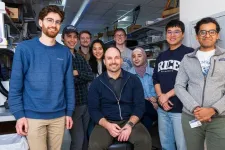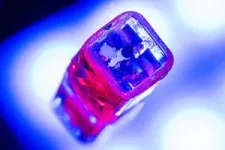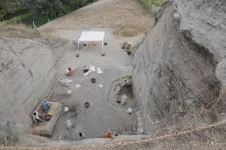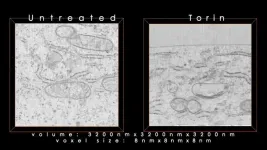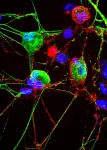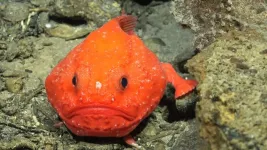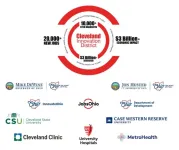(Press-News.org) HOUSTON – (April 12, 2024) – Rice University engineers have developed the smallest implantable brain stimulator demonstrated in a human patient. Thanks to pioneering magnetoelectric power transfer technology, the pea-sized device developed in the Rice lab of Jacob Robinson in collaboration with Motif Neurotech and clinicians Dr. Sameer Sheth and Dr. Sunil Sheth can be powered wirelessly via an external transmitter and used to stimulate the brain through the dura ⎯ the protective membrane attached to the bottom of the skull.
The device, known as the Digitally programmable Over-brain Therapeutic (DOT), could revolutionize treatment for drug-resistant depression and other psychiatric or neurological disorders by providing a therapeutic alternative that offers greater patient autonomy and accessibility than current neurostimulation-based therapies and is less invasive than other brain-computer interfaces (BCIs).
“In this paper we show that our device, the size of a pea, can activate the motor cortex, which results in the patient moving their hand,” said Robinson, a professor of electrical and computer engineering and of bioengineering at Rice. “In the future, we can place the implant above other parts of the brain, like the prefrontal cortex, where we expect to improve executive functioning in people with depression or other disorders.”
Existing implantable technologies for brain stimulation are powered by relatively large batteries that need to be placed under the skin elsewhere in the body and connected to the stimulating device via long wires. Such design limitations require more surgery and subject the individual to a greater burden of hardware implantation, risks of wire breakage or failure and the need for future battery replacement surgeries.
“We eliminated the need for a battery by wirelessly powering the device using an external transmitter,” explained Joshua Woods, an electrical engineering graduate student in the Robinson lab and lead author on the study published in Science Advances. Amanda Singer, a former graduate student in Rice’s applied physics program who is now at Motif Neurotech, is also a lead author.
The technology relies on a material that converts magnetic fields into electrical pulses. This conversion process is very efficient at small scales and has good misalignment tolerance, meaning it does not require complex or minute maneuvering to activate and control. The device has a width of 9 millimeters and can deliver 14.5 volts of stimulation.
“Our implant gets all of its energy through this magnetoelectric effect,” said Robinson, who is founder and CEO of Motif, a startup working to bring the device to market. “The physics of that power transfer makes this much more efficient than any other wireless power transfer technologies under these conditions.”
Motif is one of several neurotech companies that are probing the potential of BCIs to revolutionize treatments for neurological disorders.
“Neurostimulation is key to enabling therapies in the mental health space where drug side effects and a lack of efficacy leave many people without adequate treatment options,” Robinson said.
The researchers tested the device temporarily in a human patient, using it to stimulate the motor cortex ⎯ the part of the brain responsible for movement ⎯ and generating a hand movement response. They next showed the device interfaces with the brain stably for a 30-day duration in pigs.
“This has not been done before because the quality and strength of the signal needed to stimulate the brain through the dura were previously impossible with wireless power transfer for implants this small,” Woods said.
Robinson envisions the technology being used from the comfort of one’s home. A physician would prescribe the treatment and provide guidelines for using the device, but patients would retain complete control over how the treatment is administered.
“Back home, the patient would put on their hat or wearable to power and communicate with the implant, push ‘go’ on their iPhone or their smartwatch and then the electrical stimulation from that implant would activate a neuronal network inside the brain,” Robinson said.
Implantation would require a minimally invasive 30-minute procedure that would place the device in the bone over the brain. Both the implant and the incision would be virtually invisible, and the patient would go home the same day.
“When you think about a pacemaker, it’s a very routine part of cardiac care,” said Sheth, professor and vice-chair of research, McNair Scholar and Cullen Foundation Endowed Chair of Neurosurgery at the Baylor College of Medicine. “In neurological and psychiatric disorders, the equivalent is deep brain stimulation (DBS), which sounds scary and invasive. DBS is actually quite a safe procedure, but it’s still brain surgery, and its perceived risk will place a very low ceiling on the number of people who are willing to accept it and may benefit from it. Here’s where technologies like this come in. A 30-minute minor procedure that is little more than skin surgery, done in an outpatient surgery center, is much more likely to be tolerated than DBS. So if we can show that it is about as effective as more invasive alternatives, this therapy will likely make a much larger impact on mental health.”
For some conditions, epilepsy for example, the device may need to be on permanently or most of the time, but for disorders such as depression and OCD, a regimen of just a few minutes of stimulation per day could suffice to bring about the desired changes in the functioning of the targeted neuronal network.
In terms of next steps, Robinson said that on the research side he is “really interested in the idea of creating networks of implants and creating implants that can stimulate and record, so that they can provide adaptive personalized therapies based on your own brain signatures.” From the therapeutic development standpoint, Motif Neurotech is in the process of seeking FDA approval for a long-term clinical trial in humans. Patients and caregivers can sign up on the Motif Neurotech website to learn when and where these trials will begin.
The work was supported in part by The Robert and Janice McNair Foundation, the McNair Medical Institute, DARPA and the National Science Foundation.
-30-
This news release can be found online at news.rice.edu.
Follow Rice News and Media Relations via Twitter @RiceUNews.
Peer-reviewed paper:
Miniature battery-free epidural cortical stimulators | Science Advances | DOI: 10.1126/sciadv.adn0858
Authors: Joshua Woods, Amanda Singer, Fatima Alrashdan, Wendy Tan, Chufeng Tan, Sunil Sheth, Sameer Sheth and Jacob Robinson
https://doi.org/10.1126/sciadv.adn0858
Video is available at:
https://youtu.be/jhAEpAJGKSE
(Video by Brandon Martin/Rice University)
Image downloads:
https://news-network.rice.edu/news/files/2024/04/240213_Implant_Fitlow_152-5b1ea18ebb9fdfc8.jpg
CAPTION: Rice University’s Jacob Robinson and his team of researchers have developed the smallest implantable brain stimulator demonstrated in a human patient that could revolutionize treatment for drug-resistant depression and other psychiatric or neurological disorders. (Photo by Jeff Fitlow/Rice University)
https://news-network.rice.edu/news/files/2024/04/JWF_8628-39b4feadc43c1c91.jpg
CAPTION: Joshua Woods (from left), Jacob Robinson and Fatima Alrashdan (Photo by Jeff Fitlow/Rice University)
https://news-network.rice.edu/news/files/2024/04/JWF_8453-a3f45ee916b1ce90.jpg
CAPTION: Rice University engineers have developed the first miniaturized brain stimulator shown to work in a human patient. (Photo by Jeff Fitlow/Rice University)
Box Link:
https://rice.box.com/s/il8b8lxzkekxxodzb1peqpjwcpv97a3c
Links:
Robinson lab: www.robinsonlab.com
Sheth lab: https://www.bcm.edu/research/faculty-labs/functional-and-cognitive-neurophysiology-laboratory
Motif Neurotech: www.motifneuro.tech
Rice Neuroengineering Initiative: neuroengineering.rice.edu
Rice Department of Electrical and Computer Engineering: eceweb.rice.edu
Rice Department of Bioengineering: https://bioengineering.rice.edu/
George R. Brown School of Engineering: engineering.rice.edu
About Rice:
Located on a 300-acre forested campus in Houston, Rice University is consistently ranked among the nation’s top 20 universities by U.S. News & World Report. Rice has highly respected schools of architecture, business, continuing studies, engineering, humanities, music, natural sciences and social sciences and is home to the Baker Institute for Public Policy. With 4,574 undergraduates and 3,982 graduate students, Rice’s undergraduate student-to-faculty ratio is just under 6-to-1. Its residential college system builds close-knit communities and lifelong friendships, just one reason why Rice is ranked No. 1 for lots of race/class interaction, No. 2 for best-run colleges and No. 12 for quality of life by the Princeton Review. Rice is also rated as a best value among private universities by Kiplinger’s Personal Finance.
END
Rice team demonstrates miniature brain stimulator in humans
Tiny skull implant places Rice lab at the forefront of neurotech research
2024-04-12
ELSE PRESS RELEASES FROM THIS DATE:
Jennifer Stinson receives prestigious Barer-Flood Prize in health services research
2024-04-12
Jennifer Stinson a renowned researcher in the field of chronic pain management in children, has received the 2023 Barer-Flood Prize from the Canadian Institutes of Health Research (CIHR).
The prize, named in honour of the first two Scientific Directors of CIHR-IHSPR, Drs. Morris Barer and Colleen Flood, recognizes the highest-ranking senior-career investigator who identifies as a woman, and their research excellence.
Dr. Stinson, a Professor at the Lawrence Bloomberg Faculty of Nursing, Institute of Health Policy, Management and Evaluation, and Temerty Department of Anesthesiology & Pain Medicine, is being acknowledged ...
First insights into the genetic bottleneck characterizing early sheep husbandry in the Neolithic period
2024-04-12
Modern Eurasian sheep predominantly belong to only two so-called genetic matrilineages inherited through the ewes. Previous research thereby assumed that genetic diversity must already have decreased rapidly in the early stages of domestication of wild sheep. Our study of a series of complete mitogenomes from the early domestication site Asıklı Höyük in central Anatolia, which was inhabited between 10,300 and 9,300 years ago, disproves this assumption: despite a millennium of human interference with the keeping and breeding of sheep, mitogenomic diversity remained invariably high, with five matrilineages ...
Theories that explain the crisis in democracy are inadequate for Latin America, experts say
2024-04-12
The theories offered by the dominant literature in political science today to try to explain the sources of the political polarization that has endangered democracy around the world are adequate for the United States and Europe, but do not make sense for the countries of Latin America. For this reason, greater collaboration among political scientists is needed to identify other, more plausible hypotheses for the phenomenon that the region is also experiencing.
The assessment was made by researchers participating in a panel discussion on democracy and social inclusion held on April 9 in Chicago (United States) during FAPESP Week Illinois https://fapesp.br/week/2024/illinois.
“There’s ...
Starving cells hijack protein transport stations
2024-04-12
A new study details how nutrient-starved cells divert protein transport stations to cellular recycling centers to be broken down, highlighting a novel approach cells use to deal with stressful conditions.
New proteins bound for outside the cell are manufactured on the endoplasmic reticulum (ER) – a snaking membrane inside the cell. Grape-like tubular outgrowths on the ER called ER exit sites serve as transport stations, collecting these newly synthesized proteins and delivering them to the next step in their journey.
In recent ...
Where have all the right whales gone?
2024-04-12
DURHAM, N.C. – Marine researchers have mapped the density of one of the most endangered large whale species worldwide, the North Atlantic right whale, using newly analyzed data to predict and help avoid whales’ harmful, even fatal, exposure to commercial fishing and vessel strikes.
Duke University’s Marine Geospatial Ecology Lab led a collaboration of 11 institutions in the United States that pooled 17 years of available visual survey data covering 9.7 million square kilometers of the U.S. ...
Researchers find no link between COVID-19 virus and development of asthma in children
2024-04-12
Philadelphia, April 12, 2024 – In the wake of the COVID-19 pandemic, many families worried about the long-term effects posed by the SARS-COV-2 virus. Now, researchers from Children’s Hospital of Philadelphia (CHOP) found that a SARS-COV-2 infection likely does not increase the risk of asthma development in pediatric patients. The findings were published today in the journal Pediatrics.
Respiratory viral infections early in life are risk factors for asthma. Since the SARS-COV-2 virus can cause severe lung inflammation and prolonged respiratory symptoms in certain patients, many families were concerned whether COVID-19 might trigger an asthma diagnosis in their children. CHOP ...
Cell’s ‘garbage disposal’ may have another role: helping neurons near skin sense the environment
2024-04-12
The typical job of the proteasome, the garbage disposal of the cell, is to grind down proteins into smaller bits and recycle some of those bits and parts. That’s still the case, for the most part, but, Johns Hopkins Medicine researchers, studying nerve cells grown in the lab and mice, say that the proteasome’s role may go well beyond that.
Its additional role, say the researchers, may shift from trash sorter to signal messenger in dorsal root ganglion neurons — cells that convey sensory signals from nerve cells close to the skin to the central nervous system.
Results of their experiments, published April 12 in Cell Reports, show that proteasomes may help those specialized ...
Study reveals potential to reverse lung fibrosis using the body’s own healing technique
2024-04-12
he most common type of lung fibrosis — scarring of the lungs -- is idiopathic, meaning of unknown cause.
Researchers are urgently trying to find ways to prevent or slow idiopathic pulmonary fibrosis (IPF) and related lung conditions, which can cause worsening shortness of breath, dry cough, and extreme fatigue. Average survival following diagnosis of IPF is just three to five years, and the disease has no cure.
A recent U-M study from a team led by Sean Fortier, M.D. and Marc Peters-Golden, M.D. of the Division ...
International team co-led by a BSC researcher discovers more than 50 new deep-sea species in one of the most unexplored areas of the planet
2024-04-12
An international group of scientists, co-led by researcher Ariadna Mechó of the Barcelona Supercomputing Center - Centro Nacional de Supercomputación (BSC-CNS), observed 160 species on seamounts off the coast of Chile that had not yet been known to live in the region and suspect that at least 50 of these species are new to science. The recent Schmidt Ocean Institute expedition to the underwater mountains of the Salas y Gómez Ridge, a remote and underexplored area that stretches from ...
Cleveland Innovation District partners exceeding many targets set by state and JobsOhio
2024-04-12
CLEVELAND – Since the Cleveland Innovation District launched in 2021, the founding institutions have made significant progress, including exceeding many of the targets set by the Ohio Department of Development and JobsOhio. Collectively, the institutions participating in this $500 million public-private initiative have created more than 2,600 jobs, spent nearly $1.2 billion on research and innovation, commenced construction of two new research facilities, created dedicated research space comprising more than 550,000 square feet, and awarded more than 7,300 degrees and certificates to support workforce development.
“The Cleveland Innovation District’s progress ...
LAST 30 PRESS RELEASES:
Superradiant spins show teamwork at the quantum scale
Cleveland Clinic Research links tumor bacteria to immunotherapy resistance in head and neck cancer
First Editorial of 2026: Resisting AI slop
Joint ground- and space-based observations reveal Saturn-mass rogue planet
Inheritable genetic variant offers protection against blood cancer risk and progression
Pigs settled Pacific islands alongside early human voyagers
A Coral reef’s daily pulse reshapes microbes in surrounding waters
EAST Tokamak experiments exceed plasma density limit, offering new approach to fusion ignition
Groundbreaking discovery reveals Africa’s oldest cremation pyre and complex ritual practices
First breathing ‘lung-on-chip’ developed using genetically identical cells
How people moved pigs across the Pacific
Interaction of climate change and human activity and its impact on plant diversity in Qinghai-Tibet plateau
From addressing uncertainty to national strategy: an interpretation of Professor Lim Siong Guan’s views
Clinical trials on AI language model use in digestive healthcare
Scientists improve robotic visual–inertial trajectory localization accuracy using cross-modal interaction and selection techniques
Correlation between cancer cachexia and immune-related adverse events in HCC
Human adipose tissue: a new source for functional organoids
Metro lines double as freight highways during off-peak hours, Beijing study shows
Biomedical functions and applications of nanomaterials in tumor diagnosis and treatment: perspectives from ophthalmic oncology
3D imaging unveils how passivation improves perovskite solar cell performance
Enriching framework Al sites in 8-membered rings of Cu-SSZ-39 zeolite to enhance low-temperature ammonia selective catalytic reduction performance
AI-powered RNA drug development: a new frontier in therapeutics
Decoupling the HOR enhancement on PtRu: Dynamically matching interfacial water to reaction coordinates
Sulfur isn’t poisonous when it synergistically acts with phosphine in olefins hydroformylation
URI researchers uncover molecular mechanisms behind speciation in corals
Chitin based carbon aerogel offers a cleaner way to store thermal energy
Tracing hidden sources of nitrate pollution in rapidly changing rural urban landscapes
Viruses on plastic pollution may quietly accelerate the spread of antibiotic resistance
Three UH Rainbow Babies & Children’s faculty elected to prestigious American Pediatric Society
Tunnel resilience models unveiled to aid post-earthquake recovery
[Press-News.org] Rice team demonstrates miniature brain stimulator in humansTiny skull implant places Rice lab at the forefront of neurotech research
